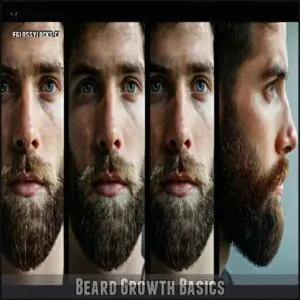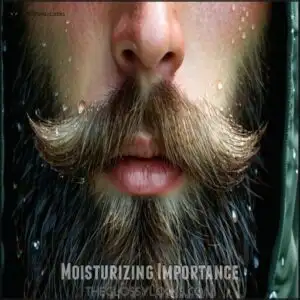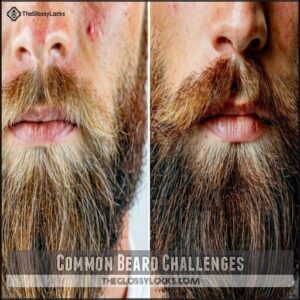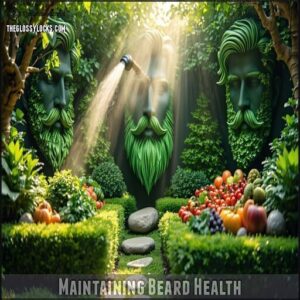This site is supported by our readers. We may earn a commission, at no cost to you, if you purchase through links.
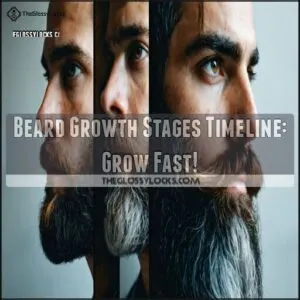 Your beard growth timeline typically follows 5 main stages.
Your beard growth timeline typically follows 5 main stages.
You’ll first notice stubble (3-5 days), then patchy growth (2-4 weeks) when things get itchy—like wearing a tiny cactus on your face.
By months 1-2, you’ll enter the filling-in stage where patches connect.
Months 2-3 bring the full beard phase, while months 3-6 allow for serious length.
Remember, this beard growth stages timeline varies based on your genetics and hormones. Some guys sprint to fullness while others take the scenic route. The secret to a magnificent beard isn’t just patience—proper care makes all the difference.
Table Of Contents
- Key Takeaways
- Beard Growth Basics
- Early Beard Growth
- Beard Development Stages
- Factors Affecting Growth
- Beard Care Essentials
- Common Beard Challenges
- Maintaining Beard Health
- Frequently Asked Questions (FAQs)
- What is the 4 week beard rule?
- What is the rule 5 for beards?
- How long is the awkward stage of beard growth?
- Can beard growth be permanently accelerated?
- How do climate and seasons affect beards?
- Do beard growth supplements actually work?
- When should teenagers start beard grooming?
- Can facial massage stimulate beard growth?
- Conclusion
Key Takeaways
- Your beard growth follows five main stages: stubble (3-5 days), patchy growth (2-4 weeks), filling-in (1-2 months), full beard (2-3 months), and serious length (3-6 months)—though your timeline varies based on genetics and hormones.
- You’ll need patience during the early growth stages when itchiness peaks—regular moisturizing with beard oil prevents discomfort and promotes healthier growth as you push through the patchy phase.
- Your lifestyle significantly impacts beard development—proper nutrition (especially protein, zinc, and iron), regular exercise (which boosts testosterone), quality sleep, and stress management all contribute to optimal beard growth.
- You can’t permanently accelerate growth beyond your genetic potential, but consistent care (daily washing, oiling, and strategic trimming) will help you achieve your best possible beard—don’t judge your beard’s potential until you’ve grown it for at least 4 weeks.
Beard Growth Basics
You’re about to learn the basics of beard growth, and understanding that your genetics, age, and hormones play a significant role in how your beard develops is key.
As you start your beard growth journey, you’ll discover how these factors impact your progress, and with the right knowledge, you can take control of your beard’s health and growth.
Genetics Role
How does genetics impact your beard growth?
Your ancestry influence and beard heritability play a significant role, determining hair follicles and growth patterns.
DHT affecting facial hair growth, shaping your unique beard genetics and overall beard growth stages and timeline.
Genetics set your beard’s potential.
Age Factor
As it pertains to beard growth stages, age matters. Peak growth often happens between 25 and 35.
You’ll notice growth slows down as you age, but mature beards can still look awesome. The graying process might start, too.
Hormones like DHT play a vital role in this process.
- Growth slowdown in your 60s.
- Texture changes as you age.
- Full beard possible at 18, but maybe not until 30!
Remember, beard growth and age have a unique beard timeline.
Hormones Influence
Hormones play a big role in your beard’s journey.
Testosterone and DHT (dihydrotestosterone) drive thickness and growth.
Low levels? You might see sluggish progress.
Hormone imbalances can slow things, but lifestyle changes or medical intervention often help.
Remember, it’s all part of the beard timeline—patience is key!
| Key Hormones | Impact | Solutions |
|---|---|---|
| Testosterone | Affects beard growth | Exercise, sleep |
| DHT | Thickens facial hair | Hormone therapy (if needed) |
| Imbalances | Slower growth | Consult a doctor |
Early Beard Growth
You’re stepping into the early stages of beard growth, where stubble starts to emerge and itching can test your patience.
Keep your skin moisturized and stick to a simple routine to get through this tricky, yet rewarding, phase.
Stubble Stage
The stubble stage kicks off your beard growth journey, typically within the first week.
I’ll create a short, engaging blockquote that captures the essence of the stubble stage of beard growth in the same informative yet conversational tone:
That first week of stubble—rough, promising, and the gateway to your beard journey.
It’s rough, patchy, and a bit itchy, but those tiny sprouting hairs signal progress.
Exfoliation benefits your skin while helping soften the stubble.
Use a light moisturizer or oil to manage itch and dry skin, and experiment with styling options early to shape your facial hair growth.
Itchiness Issues
In the early beard growth stages, itchiness strikes like an unwelcome guest during the first week, thanks to sharp stubble irritating skin.
Thankfully, you’ve got options:
- Wash daily to reduce grime.
- Apply beard oil to soften and soothe.
- Use a gentle brush to exfoliate.
- Avoid scratching to prevent irritation.
- Seek professional help if itch persists.
Many find relief through specialized beard products, which can be a specialized solution for persistent itch.
Moisturizing Importance
How do you keep your beard from feeling like sandpaper? Moisturizing is key!
Use beard oil daily for itch prevention and healthy growth. Balm hydration locks in moisture, tackling dandruff control while softening hair.
Remember, happy facial skin means smoother beard growth stages.
Check this quick guide:
| Problem | Solution | Benefit |
|---|---|---|
| Itchy Beard | Use Beard Oil | Itch Prevention |
| Dry Skin | Apply Balm | Hydrated Skin |
| Flaky Dandruff | Moisturize Daily | Dandruff Control |
Beard Development Stages
Growing a beard is all about patience, and you’ll notice it passes through several fascinating stages.
From patchy spots to a full, glorious beard, understanding each phase helps you tackle challenges like itchiness or uneven growth with confidence.
Patchy Growth
Patchy growth is a normal part of the beard growth timeline, often testing your patience.
Hair fills in unevenly during this stage, thanks to genetic factors and the natural beard growth cycle.
Focus on growth stimulation with beard oil, keeping skin healthy.
For patch coverage, try light trimming or styling options. Remember, every patchy beard is temporary—trust the process!
Full Beard Achievement
After those patchy days, you’ve finally reached the promised land – full beard achievement! Your perseverance has paid off, and that majestic beard goal is now reality.
During this beard development stage, your focus shifts to fullness maintenance and exploring styling options.
- Daily brushing to distribute natural oils
- Regular trimming to maintain your desired beard length
- Experimenting with different beard growth timeline charts to track your progress
Enjoy the beard envy you’ll inspire!
Long Beard Care
Your long beard is like a majestic forest that requires dedicated maintenance.
Once you’ve reached significant beard length, daily grooming becomes essential to prevent tangles and split ends.
Use a wide-tooth comb for tangle prevention, and apply beard oil to combat dandruff control.
Trim every 4-6 weeks for healthy growth, and consider beard products specifically designed for longer styles.
For ideal results, a quality beard grooming kit can be beneficial, and trust me, proper beard care makes all the difference!
Factors Affecting Growth
You’ll be surprised how much control you actually have over your beard’s growth, despite what your beardless uncle might claim.
Your genetics provide the foundation, but factors like diet, exercise, sleep quality, and stress levels can turn your facial fuzz from patchy to impressive.
Diet Impact
What you put on your plate directly impacts your beard growth stages timeline.
A well-balanced diet rich in protein intake fuels stronger follicles, while vitamins influence thickness and shine.
Mineral deficiencies, especially zinc and iron, can lead to patchy growth.
Hydration effects can’t be overlooked—water delivers nutrients to follicles. Your beard literally eats what you eat, so choose wisely!
Exercise Benefits
Getting your heart pumping does wonders for your beard.
Regular exercise boosts testosterone levels, especially through weightlifting, which directly promotes thicker beard growth.
Working out also improves circulation, delivering essential nutrients to your facial follicles.
As you sweat, you’re unclogging pores and creating the perfect environment for healthy beard growth.
For best results, combine lower body exercises with upper body training to maximize your beard’s potential.
Lifestyle Influence
While your muscles recover from exercise, your lifestyle choices continue working behind the scenes of beard growth.
Your daily habits—from Sleep Quality to Stress Reduction—directly impact how quickly and fully your facial hair develops.
Smoking Effects can restrict blood flow to follicles, while Diet Choices rich in proteins and vitamins fuel growth.
Balancing work, rest, and nutrition creates the perfect environment for that magnificent beard you’re aiming for.
Beard Care Essentials
You’ll need the right tools in your beard-growing arsenal, just like a knight needs proper armor for battle.
Your daily routine of oils, regular washing, and careful trimming will transform that patchy stubble into a majestic facial masterpiece.
Oil and Balm Use
Regularly applying beard oil nourishes your hair follicles while preventing the dreaded beard itch.
You’ll want to massage 3-5 drops of oil into your beard daily, focusing on the skin beneath.
Beard balm, your styling buddy, provides hold and additional moisturizing benefits.
When selecting products, look for natural ingredients like jojoba oil and shea butter—they’re your beard’s best friends for maintaining softness and manageability.
Proper application of quality beard products can improve beard health.
Regular Washing
While beard oils and balms nourish your facial forest, proper washing keeps it clean and healthy.
Your beard collects more than compliments—it traps food, dirt, and natural oils throughout the beard growth process.
- Use beard-specific shampoo twice weekly to prevent stripping natural oils
- Lukewarm water opens follicles without causing dryness
- Massage gently to stimulate blood flow during facial hair growth
- Rinse thoroughly to prevent residue buildup (your skin will thank you!)
- Pat dry instead of rubbing to avoid frizz and breakage
Trimming Techniques
Now that your beard is fresh and clean, it’s time for trimming. Define your neckline about two fingers above your Adam’s apple for a natural look.
Shape your cheek line to complement your face, using scissors for precision or a trimmer for speed. Remember, beard maintenance isn’t about chopping everything off—it’s about strategic grooming to enhance your beard styles while keeping length maintenance on point.
For best results, consider high-quality trimmers for precision.
Common Beard Challenges
You’ll face several roadblocks on your beard growth journey, from patchy spots that make you look like you’ve got moths in your facial fur to that maddening itch that makes you question your life choices.
Don’t worry though – with the right techniques, you can tackle these common beard challenges and still achieve that magnificent mane you’re dreaming of, and overcome the difficulties to get the desired result with right techniques.
Patchiness Solutions
Don’t panic when facing a patchy beard! Embrace patience as beard follicles grow at different rates.
For stubborn patchiness, consider minoxidil application or derma rolling to stimulate growth. Growth supplements containing biotin may help increase beard thickness and density.
While waiting for natural development, try concealing techniques with strategic trimming. Remember, many full beards started patchy—uneven growth often resolves with time.
Lifestyle adjustments, like stress reduction techniques, can also substantially help to improve beard growth and overall well-being with patience.
Itchiness Relief
That itchy beard driving you crazy isn’t a permanent sentence.
Combat beard itch with daily moisturizing using Beard Oil containing natural remedies like tea tree oil.
Regular exfoliation benefits your facial skin by removing dead cells.
Try cooling agents like aloe vera or products with menthol for instant relief.
Proper hydration techniques and checking product ingredients for irritants will keep your beard grooming routine itch-free.
Split Ends Prevention
Those pesky beard split ends can ruin your otherwise magnificent facial masterpiece. Your beard needs daily care to stay healthy and split-end free.
Here’s how to protect your beard from splitting:
- Use hydrating beard oils to maintain moisture balance
- Trim every 2-3 weeks with sharp scissors
- Gently comb with a wide-tooth comb, not a brush
Heat styling tools damage hair, so avoid them completely when possible. Many men find quality beard products essential for beard maintenance.
Maintaining Beard Health
You’ll need to care for your beard like a prized garden if you want it to flourish through every growth stage.
Your daily routine of proper grooming, balanced nutrition, and stress management will transform that facial fuzz from scruffy to spectacular.
Daily Grooming
Consistently tending to your beard transforms it from merely facial hair to a distinguished feature.
Your daily beard journey should include gentle beard brushing to distribute natural oils, followed by oil application to moisturize skin and hair.
Apply balm benefits for styling control, and don’t forget mustache trimming to keep food interactions minimal.
Routine consistency is key—establish morning and evening beard care rituals for superior maintenance and impressive beard progress.
Nutrition Importance
Your daily beard care routine won’t yield the best results without proper fuel.
Your beard needs nutrients to thrive! A well-balanced diet rich in protein builds those facial follicles, while vitamins A, B, C, D, and E support growth from within.
Minerals like zinc and iron are beard growth superheroes. Stay hydrated too—water helps nutrients reach your follicles.
Think of dietary supplements as backup players when your meals fall short.
Stress Management
During times of high stress, your beard growth can take a significant hit.
Stress elevates cortisol levels, which disrupts hormone balance and slows hair development.
- Practice daily meditation or deep breathing to reduce anxiety
- Get 7-8 hours of quality sleep to balance hormones
- Exercise regularly to lower cortisol levels
- Stay hydrated and limit caffeine intake
- Set boundaries between work and personal life to reduce stress and improve overall well-being, leading to healthier hair development.
Frequently Asked Questions (FAQs)
What is the 4 week beard rule?
Just when you’re ready to give up, the 4-week beard rule kicks in.
You’ll need to wait at least 4 weeks before judging your beard’s potential, allowing patchy areas time to fill in.
What is the rule 5 for beards?
The "Rule 5" for beards isn’t a common standard. You’ll find various beard rules depending on guides, but none specifically numbered as five. Check specific beard guides for their particular recommendations.
How long is the awkward stage of beard growth?
Prickly patience pays off! Your awkward beard stage typically lasts 2-3 weeks, starting when you’ve grown beyond stubble but haven’t reached proper length for styling. You’ll get through it!
Can beard growth be permanently accelerated?
While you can’t permanently accelerate beard growth beyond your genetic potential, you can optimize it through proper nutrition, exercise, adequate sleep, and skincare.
Temporary boosts come from products containing biotin or minoxidil.
How do climate and seasons affect beards?
Your beard grows up to 60% faster in summer than winter.
Warmer months boost testosterone and vitamin D levels, speeding up growth, while cold weather slows circulation and dries out facial hair.
Seasonal beard care isn’t just a hairy situation—it’s science!
Do beard growth supplements actually work?
Most beard supplements lack solid scientific backing.
While biotin and vitamins may support general hair health, they won’t transform your patchy beard overnight.
Your genetics ultimately determine your growth potential, not pills.
When should teenagers start beard grooming?
Start grooming when you notice facial hair, typically around 14-16 years old.
You’ll want to begin with basic cleansing and moisturizing, gradually adding tools as your beard develops.
Everyone’s timeline differs!
Can facial massage stimulate beard growth?
Regular facial massage can potentially stimulate beard growth by increasing blood circulation to hair follicles.
You’ll see modest results when combined with proper nutrition and genetics still play the biggest role.
Conclusion
Like Odysseus journeying home to Ithaca, your beard growth stages timeline is a personal adventure worth embracing.
You’ll face the stubble seas, navigate patchy islands, and finally reach the full-bearded promised land.
Remember, genetics set your course, but proper care speeds the voyage.
Whether you’re a swift grower or taking the scenic route, patience and consistent grooming will transform your facial forest into something truly magnificent.
Trust the process—your best beard awaits.

